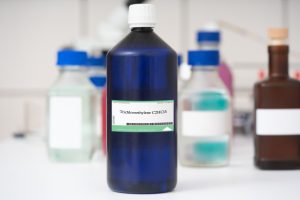TCE and Parkinson’s disease risk
Like most chronic diseases, the chance of developing Parkinson’s disease (PD) is due to an accumulation of both genetic and environmental risk factors. Researchers are working to identify as many of these risk factors as possible as well as to understand what causes a person to develop Parkinson’s.
For many reasons, it is very difficult to establish a relationship between exposure to a particular chemical and development of PD. With enough careful study however, certain associations may begin to reveal themselves. For example, the herbicide paraquat is now considered an environmental risk factor for PD. Paraquat is banned in 32 countries around the world, but still permitted in the US. Recently, environmental groups, agricultural workers groups and Parkinson’s disease advocates have sued the Environmental Protection Agency (EPA) after it issued an interim re-approval for paraquat. Whether this lawsuit will lead to a ban on paraquat in the US is yet to be determined.
Recently, two papers have shone a spotlight on the link between exposure to another chemical, trichloroethylene (TCE) and PD. TCE is ubiquitous, mostly used in manufacturing as a solvent for degreasing metal parts as well as in the manufacturing of other chemicals. It can also be found in consumer products, including some wood finishes, adhesives, paint removers, and stain removers.
An Invisible Cause
In Trichloroethylene: An Invisible Cause of Parkinson’s Disease, the authors argue that TCE may be an environmental risk factor for PD, contributing to the increase in global cases of PD. The authors present the currently available data of the connection between PD and TCE which consists mostly of cases of people with PD who had had TCE exposure. The authors also present data from animal testing in which TCE treatment caused death of dopamine neurons as well as neuro-inflammation and alpha-synuclein phosphorylation and accumulation.
To this literature, the authors add seven of their own cases of people with PD with known TCE exposure but are very frank about the limitations of this approach as proof of causation between PD and TCE exposure.
The authors present this work as a hypothesis and clearly state that more work is needed to understand the connection between TCE and PD. In the meantime, there are well established health risks of TCE exposure, including development of various cancers. Therefore, 1) educating the public about known health risks, 2) working to clean up known sites of contamination, and 3) advocating to ban future use of the substance are all important goals to try to attain that do not need to wait for firm causation between TCE and PD.
A Study on Service Members
Within Risk of Parkinson Disease Among Service Members at Marine Corps Base Camp Lejeune researchers focused on exposure to waters contaminated by TCE and other chemicals at Camp Lejeune. Camp Lejeune is a US Marine Corps training facility in North Carolina. From the 1950s through the 1980s, solvents, including TCE, were buried in base wells in the camp which seeped into the water supply. The Caring for Camp Lejeune Families Act was passed in 2012 and stipulated that qualifying veterans and their families were eligible to receive all their healthcare from the Veterans Administration (VA) if they served on active duty at Camp Lejeune during the time when the water supply was contaminated, no matter what healthcare conditions they may have. PD is named as one of eight conditions that entitle veterans to disability compensation after Camp Lejeune exposure.
Although these laws suggest that the VA presumes a diagnosis of PD is related to exposure to contaminants at Camp Lejeune, this has yet to be proven definitively. The current study therefore reviewed medical records of 340,489 service members and found that the risk of PD was 70% higher in those who were stationed at Camp Lejeune, compared with veterans stationed at Camp Pendleton, whose waters were not contaminated. Veterans without PD stationed at Camp Lejeune had a significantly higher risk of several prodromal features of PD, symptoms that tend to present before a diagnosis of PD, such as anxiety.
Both papers offer compelling arguments that TCE exposure may be a potential cause of PD and exposure to TCE should be limited as much as possible.
Genetic Predisposition and Exposures to Environmental Toxins Research
In addition to understanding each environmental risk factor in isolation, it is important to highlight that genes and environment can work together to increase the risk of developing PD.
In June 2021, the laboratory of Dr. Tim Greenamyre, the medical director of the APDA Center for Advanced Research at University of Pittsburgh and member of APDA’s Scientific Advisory Board published a paper in Neurobiology of Disease entitled The industrial solvent trichloroethylene induces LRRK2 kinase activity and dopaminergic neurodegeneration in a rat model of Parkinson’s disease. In this paper, the relationship between a genetic predisposition to PD and exposure to an environmental toxin was studied. The study demonstrated that exposure of rats to TCE induced the activation of LRRK2, an enzyme that when mutated is a genetic risk factor for PD. TCE exposure also produced a significant dopaminergic lesion in the nigrostriatal tract, elevated oxidative stress, and caused α-synuclein accumulation. The paper concluded that gene-environment interactions between TCE and LRRK2 are likely to influence PD risk.
All in all, further research into environmental exposures will help us not only understand what increases PD risk but can help us make the changes necessary to improve the health of all those that interact with the environment.
If you are concerned about a known or likely exposure to TCE, you should address it with your doctor.
Tips and Takeaways
- Exposure to TCE, a ubiquitous chemical mostly used in manufacturing as a solvent for degreasing metal parts, may increase the risk of PD.
- Genes and environment often work together to increase the risk of developing PD.
- To learn more about PD and the environment, watch this interesting episode of APDA’s Dr. Gilbert Hosts, with special guest Dr. Carlie Tanner.

